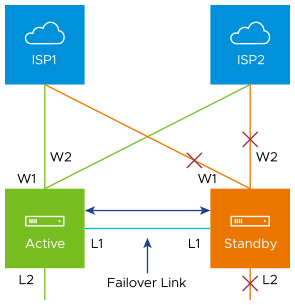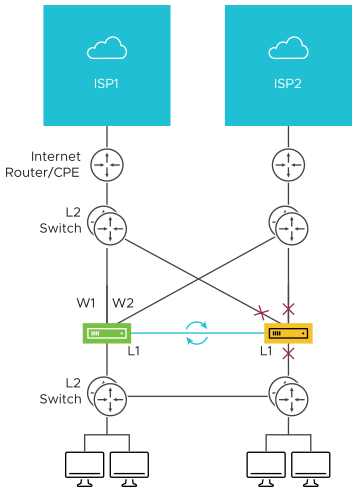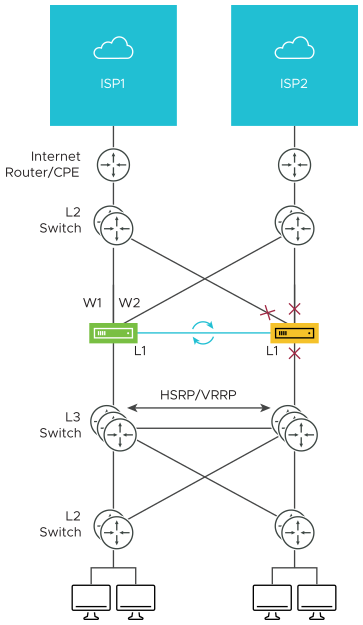This section describes Standard HA.
Topology Overview for Standard HA
The following figure shows a conceptual overview of Standard HA.

The Edges, one Active and one Standby, are connected by L1 ports to establish a failover link. The Standby SD-WAN Edge blocks all ports except the L1 port for the failover link.
Prerequisites for Standard HA
- The LAN side switches in the following configuration descriptions must be STP capable and configured with STP.
- In addition, SD-WAN Edge LAN and WAN ports must be connected to different L2 switches. If it is necessary to connect the ports to the same switch, then the LAN and WAN ports must be isolated.
- The two SD-WAN Edges must have mirrored physical WAN and LAN connections.
Deployment Types for Standard HA
- Deployment Type 1: High Availability (HA) using L2 switches
- Deployment Type 2: High Availability (HA) using L2 and L3 switches
Deployment Type 1: HA using L2 switches
The following figure shows the network connections using only L2 switches.

W1 and W2 are WAN connections used to connect to the L2 switch to provide WAN connectivity to both ISPs. The L1 link connects the two SD-WAN Edges and is used for ‘keep-alive’ and communication between the SD-WAN Edges for HA support. The SD-WAN Edge’s LAN connections are used to connect to the access layer L2 switches.
Considerations for HA Deployment using L2 switches
- The same ISP link must be connected to the same port on both Edges.
- Use the L2 switch to make the same ISP link available to both Edges.
- The Standby SD-WAN Edge does not interfere with any traffic by blocking all its ports except the failover link (L1 port).
- Session information is synchronized between the Active and Standby SD-WAN Edges through the failover link.
- If the Active Edge detects a loss of a LAN link, it will also failover to the Standby if it has an Active LAN link.
Deployment Type 2: HA using L2 and L3 Switches
The following figure shows the network connections using L2 and L3 switches.

The SD-WAN Edge WAN connections (W1 and W2) are used to connect to L2 switches to provide a WAN connection to ISP1 and ISP2 respectively. The L1 connections on the SD-WAN Edge are connected to provide a failover link for HA support. The VMware Edge LAN connections are used to connect L2 Switches, which have several end-user devices connected.
Considerations for HA Deployment using L2 and L3 switches
- HSRP/VRRP is required on the L3 switch pair.
- The SD-WAN Edge's static route points to the L3 switches’ HSRP VIP as the next hop to reach the end stations behind L2 switches.
- The same ISP link must be connected to the same port on both SD-WAN Edges. The L2 switch must make the same ISP link available to both Edges.
- The Standby SD-WAN Edge does not interfere with any traffic by blocking all of its ports except the failover link (L1 port).
- The session information is synchronized between the Active and Standby SD-WAN Edges through the failover link.
- The HA pair also does a failover from Active to Standby on detecting the L1 loss of LAN / WAN links.
- If Active and Standby have the same number of LAN links which are up, but Standby has more WAN links up, then a switchover to Standby will occur.
- If the Standby Edge has more LAN links up and has at least one WAN link up, then a failover to the Standby will occur. In this situation, it is assumed that the Standby Edge has more users on the LAN side than the Active Edge, and that the Standby will allow more LAN side users to connect to the WAN, given that there is some WAN connectivity available.